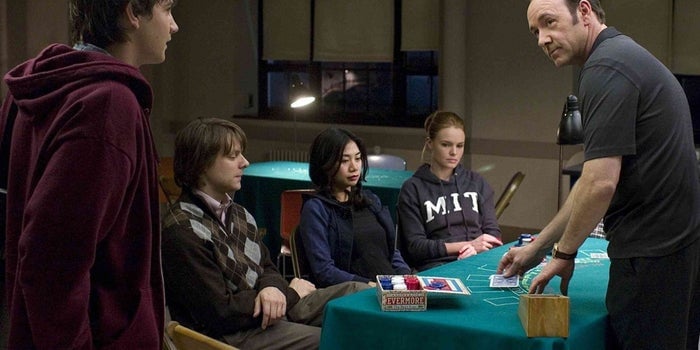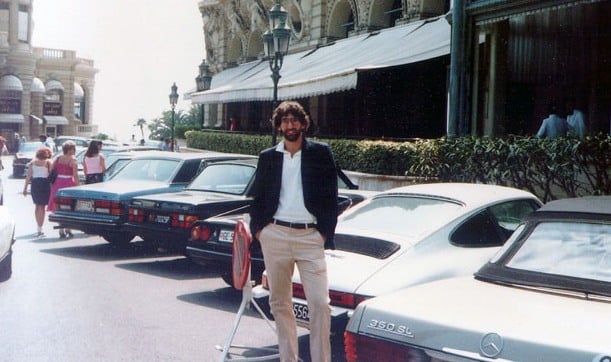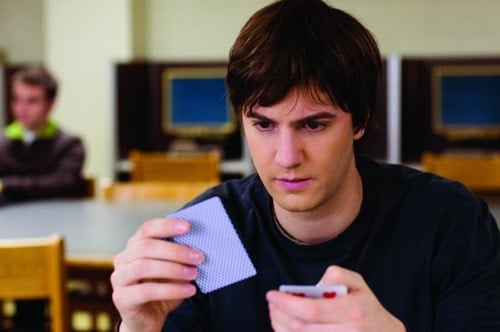How Much Money Did The Mit Blackjack Team Make
It's one of the oldest clichés in the globe of casinos: The business firm e'er wins.
Except information technology doesn't.
For more than a decade, a squad of card counters based around the Massachusetts Institute of Technology (MIT) proved that the house could exist browbeaten.

They came upward with, and put into do, a method for winning at blackjack.
The idea came from the studies of Edward Thorp, a math professor at MIT, who devised a bill of fare counting system in the 1950s using the primeval computers.
The team's success inspired a 2008 movie, 21, starring Kevin Spacey (in a higher place), and a best-selling book Bringing Downward The House.
Simply who were these guys? How did they do it? And could their methods yet work today?
The MIT Blackjack Bill of fare Counting Technique
The first thing to make articulate is that menu counting is not actually illegal – as long as y'all are counting in your head. It is a form of advantage play.
Nevada state laws, for instance, specifically prohibit card counting using electronic or mechanical aids.
All the same, legal though it may be, information technology'due south fair to say that you won't win many friends amongst casino owners if you practise the art successfully.
The simplest way of describing the "Hullo-Lo" method used by the MIT blackjack card counting squad is as follows. You count the high and low cards that have been played since the last shuffle.
You'll need to have memorized a value assigned to all cards in a deck:
- High cards (10, Jack, Queen, Male monarch and ace) count as -one
- Low cards (two, three, iv, five and 6) count as +1
- The balance count every bit 0
If information technology becomes clear as the game progresses that the cards dealt out have an overall positive value, that's the time to bet big.
Mike Aponte, one of the leading members of the MIT team, offers a uncomplicated guide to card counting on this video:
Who Were The MIT Squad?
The team came together at the start of the 1980s. A group of students at MIT taught themselves a carte-counting technique and went to Atlantic City to try it out.
I of the squad, JP Massar, overheard a conversation in a Chinese restaurant in Cambridge, where MIT is based.
The man talking was Bill Kaplan (below), who had graduated three years before but put off going to Harvard Business organisation Schoolhouse so that he could effort to go a professional gambler.
He was talking about how he had run a successful blackjack team in Las Vegas in 1977. He had gone there with $one,000 and turned it into $35,000.
Now Kaplan trained and managed a new team, run as a business organisation with formal direction procedures and stringent role player selection.
Many MIT students tried out for the team – some were accustomed. A ten-strong team rolled into activeness with an $89,000 investment in Baronial 1980 and in 10 weeks they had doubled their money.

What Was Their Strategy?
Players were recruited through fliers and discussion of mouth. Potential members were thoroughly vetted.
The process included a "trial by burn down", in which yous had to play through eight six-deck shoes with almost perfect results.
As the system kept paying off, the squad kept growing. By 1984 in that location were 35 players and during the 1980s more than 70 dissimilar people played in some capacity.
Every partnership set up by the team – there were at least 22 – was assisting. Annual dividends to investors were between iv% and more than than 300%.
The squad gear up a company, Strategic Investments, in 1992 with investment of $1million.
By at present they were using a strategy with a three-person team – a big player, a controller and a picket.
The spotter would check when the deck "went positive", while the controller was there to bet small and double-check the spotter'due south counting. When the count was verified, a bespeak would be fabricated to the big player, who would make a huge bet – often with huge returns.
Over the adjacent two years the squad grew to about 80. There were groups in Cambridge, New York, New Jersey, Pennsylvania, California, Illinois and Washington.
At times the team had up to 30 members playing simultaneously at casinos around the world.
Kaplan said: "There are tens of thousands of people who tried to win at the game, simply MIT was the only team who actually won yr over year, because we ran information technology like a business organisation.
"Training, all-encompassing training, checkout procedures, 2 hours of perfect play, leaving the tabular array right. It was really run more tightly than most businesses."

They Carried On Until They Got Caught
Gradually, the bosses realized in that location was an organized and specific campaign going on. A private detective worked out from the addresses of some involved that there was a connection with Cambridge.
Several of the more prominent team members were identified and banned from casinos. At the stop of 1993, Strategic Investments paid out earnings to players and investors and dissolved their partnership.
Casinos also became more expert at spotting card counters and shuffling the decks more frequently – as many online casinos do today.
As soon as a deck is shuffled, a menu counter has to go back to aught and the border is lost.
How Much Money Did The MIT Blackjack Squad Make?
It's impossible to say.
Carte counting is not a foolproof arrangement, merely implemented correctly information technology can give y'all an edge of betwixt 2% and 4% over the firm.
Some accept claimed that total winnings for the team were in excess of $10million, just that's impossible to verify.
Mike Aponte reckons the biggest win was nearly $500,000 on Super Bowl weekend in 1995. Meanwhile, the largest loss was $130,000.
…Where Are They At present?
Some team members carried on after Strategic Investments folded. They tried more sophisticated systems and were more careful with their recruitment. Simply by 2000 near all had drifted away from blackjack.
Bill Kaplan, the man who started information technology all, realized that he would have less hassle, and possibly more turn a profit, investing in property and business organisation.
John Chang, another prolific member of the MIT card counting team, still visits casinos. He often wears disguise so members of the public don't recognize him.
Here he is talking well-nigh the movie 21and card counting in general:
Practice Makes Perfect
By at present it should be clear that card counting tin can work – but it takes time, practice, nerves of steel and a big banking company.
You lot can practice with a carte du jour counting trainer tool. This will teach you the basics of assigning values to all cards and working out what the overall value of the dealt cards is as play progresses.
There are even more than advanced strategies that give more variation in the value ascribed to item cards.
Once you've mastered the nuts, though, it'south all nearly practice – and more than practice – so that yous tin try the technique in a live scenario.
Be wary most using it in an online blackjack game, though – cards tend to exist shuffled far more oftentimes than in a casino.
If you enjoyed this mail service, be sure to read this astonishing story about a professor who beat the roulette bicycle. He made MILLIONS!
Sources:
https://en.wikipedia.org/wiki/MIT_Blackjack_Team
https://www.bbc.co.uk/news/magazine-27519748
https://world wide web.bostonmagazine.com/arts-entertainment/2019/06/21/mit-blackjack-squad/
http://www.historyvshollywood.com/reelfaces/21mitblackjack.php
Source: https://www.casino.org/blog/mit-blackjack-card-counting/
Posted by: connersallecte.blogspot.com

0 Response to "How Much Money Did The Mit Blackjack Team Make"
Post a Comment